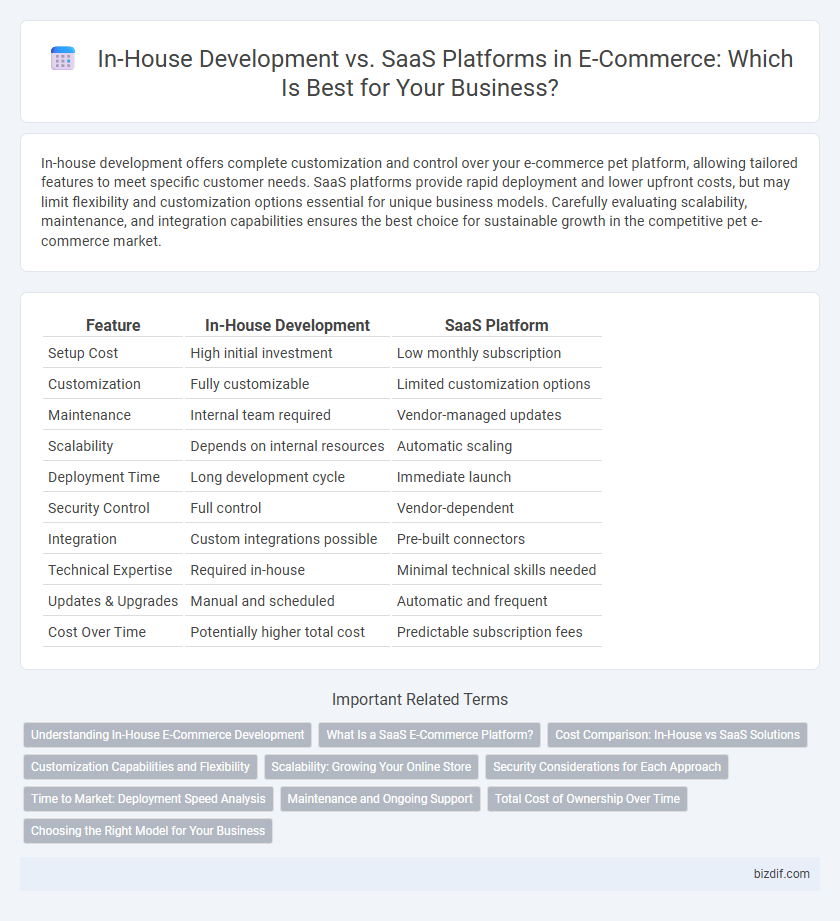In-house development offers complete customization and control over your e-commerce pet platform, allowing tailored features to meet specific customer needs. SaaS platforms provide rapid deployment and lower upfront costs, but may limit flexibility and customization options essential for unique business models. Carefully evaluating scalability, maintenance, and integration capabilities ensures the best choice for sustainable growth in the competitive pet e-commerce market.
Table of Comparison
| Feature | In-House Development | SaaS Platform |
|---|---|---|
| Setup Cost | High initial investment | Low monthly subscription |
| Customization | Fully customizable | Limited customization options |
| Maintenance | Internal team required | Vendor-managed updates |
| Scalability | Depends on internal resources | Automatic scaling |
| Deployment Time | Long development cycle | Immediate launch |
| Security Control | Full control | Vendor-dependent |
| Integration | Custom integrations possible | Pre-built connectors |
| Technical Expertise | Required in-house | Minimal technical skills needed |
| Updates & Upgrades | Manual and scheduled | Automatic and frequent |
| Cost Over Time | Potentially higher total cost | Predictable subscription fees |
Understanding In-House E-Commerce Development
In-house e-commerce development involves building and maintaining a custom platform tailored to specific business needs, providing full control over features, security, and data management. This approach demands significant investment in skilled developers, ongoing maintenance, and infrastructure costs but allows for personalized user experiences and seamless integration with existing systems. Companies with complex workflows or unique requirements often prefer in-house solutions to avoid limitations inherent in SaaS platforms.
What Is a SaaS E-Commerce Platform?
A SaaS e-commerce platform is a cloud-based software solution that enables businesses to create, manage, and scale online stores without the need for extensive in-house technical expertise. It offers built-in features such as payment processing, inventory management, and customizable storefronts, hosted and maintained by the service provider to ensure continuous updates and security. This model reduces upfront costs and accelerates time-to-market compared to traditional in-house development of e-commerce infrastructure.
Cost Comparison: In-House vs SaaS Solutions
In-house e-commerce development typically demands significant upfront investment in software engineering, infrastructure, and ongoing maintenance, leading to higher fixed costs and resource allocation. SaaS platforms offer a subscription-based pricing model that reduces initial expenditures and shifts expenses towards predictable operational costs, often including updates, security, and customer support. Businesses must evaluate long-term total cost of ownership (TCO), factoring in scalability, customization needs, and potential hidden fees to determine the most cost-effective solution.
Customization Capabilities and Flexibility
In-house development offers unparalleled customization capabilities, allowing e-commerce businesses to tailor every feature to specific operational needs and customer experiences. SaaS platforms provide flexibility through scalable solutions and regular updates but often limit deep customization due to generic architecture and preset templates. Companies prioritizing unique user interfaces and complex integrations typically benefit more from in-house development, while those seeking faster deployment and lower upfront costs lean towards SaaS options.
Scalability: Growing Your Online Store
In-house development offers customizable scalability tailored to unique business needs but requires significant resources and expertise to manage growth effectively. SaaS platforms provide built-in scalability with seamless updates and infrastructure management, enabling rapid expansion without heavy technical overhead. Choosing the right solution depends on your store's projected growth velocity, budget constraints, and long-term operational goals.
Security Considerations for Each Approach
In-house development offers complete control over security protocols, enabling tailored defenses against specific threats but requires significant resources for ongoing vulnerability management and compliance adherence. SaaS platforms provide built-in security features managed by specialized teams, ensuring regular updates and compliance with industry standards, though they may introduce risks related to data sovereignty and multi-tenant architecture. Evaluating security considerations involves balancing customization capabilities with the trust and transparency of third-party security practices.
Time to Market: Deployment Speed Analysis
In-house development often requires extensive coding, testing, and debugging phases, leading to longer deployment times compared to SaaS platforms that offer ready-made solutions and rapid integration. SaaS platforms enable businesses to launch products in weeks rather than months, accelerating time to market and allowing quicker response to market demands. Faster deployment speeds reduce overhead costs and enable continuous updates without significant downtime, giving SaaS an edge over proprietary in-house solutions.
Maintenance and Ongoing Support
In-house development requires a dedicated team for continuous maintenance and updates, leading to higher long-term operational costs and resource allocation challenges. SaaS platforms offer automated maintenance, regular feature upgrades, and 24/7 technical support, reducing downtime and ensuring consistent performance. Enterprises benefit from SaaS by avoiding infrastructure management, enabling scalability and faster issue resolution compared to in-house solutions.
Total Cost of Ownership Over Time
In-house development demands significant upfront investment in software design, infrastructure, and ongoing maintenance, leading to higher initial costs but greater customization flexibility. SaaS platforms offer lower initial expenses with subscription-based pricing, shifting costs to predictable operational expenses but may incur additional fees for scalability and integrations over time. Total cost of ownership for in-house solutions tends to increase with personnel and update needs, while SaaS costs scale with usage and feature requirements, influencing long-term budget considerations in e-commerce operations.
Choosing the Right Model for Your Business
Evaluating in-house development versus SaaS platforms requires analyzing factors such as customization needs, budget constraints, and maintenance capabilities. In-house solutions offer complete control and tailored features but demand higher upfront investment and ongoing technical support, while SaaS platforms provide scalable, cost-effective options with regular updates and minimal IT overhead. Aligning your e-commerce growth projections with operational resources ensures selecting the optimal model for maximizing efficiency and customer experience.
In-House Development vs SaaS Platform Infographic

 bizdif.com
bizdif.com